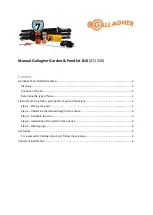
21
Appendix A
Impulse Testing Waveforms and Relay Performance
Background: Over the years, Compliance West USA has used a number of different relays to switch
impulse waveforms. Relay choice varies depending primarily on the voltage that is being switched, and the
maximum current than can flow. Other considerations include whether a single-pole or double-pole relay is
needed. The range of voltages and currents varies greatly. The purpose of this document is to provide a
better understanding of the switching event, and provide guidelines for the interpretation of measured
results.
Terminology: The following definitions are used in this document:
Switching time - The time delay starting at the point that the normally-closed contact (NC) opens,
until the normally-open contact (NO) initially closes.
Pre-arcing - During switching, the arc-over that occurs from the Common (COM) contact to the
NO contact before the NO contact initially closes.
Contact bounce - After the NO contact has initially closed, the contact may re-open because of the
mechanical impact between the COM contact and the NO contact. Contact bounce may be
reduced by dampening and spring-loading contacts.
Pre-arcing creates plasma. Plasma (according to Wikipedia) is highly conductive and can generally be
considered a short-circuit. Most research in the area of electrical arcs is generally focused on circuit
breakers and contactors that are moving from a closed state to an open state in order to disconnect the
power source from the load. In this case arcing occurs and plasma is created when the contacts begin to
open. This causes the currently to be maintained even while the contacts are open because of the low
impedance of the plasma. While this is interesting, the understanding of this event is of limited use when
considering contacts that are closing rather than opening.
For high voltage relays, switching time is relatively long, on the order of 10-20ms. This is because the
COM contact moves at a finite speed over a large contact gap distance. Therefore it is reasonable to expect
that the power source (that is charging the capacitor) is fully disconnected from the stored-energy
component (capacitor) before pre-arcing takes place.
During switching, as the COM contact is moving towards the NO contact, arcing starts. The contact gap at
which arcing occurs depends on voltage, gas composition (air or some other gas, or partial vacuum), and
contact geometry (sharp points will arc at larger distances than smooth, rounded surfaces). In fact,
for fast
impulse waveforms (such as 1.2 x 50uS) the entire waveform output will be generated during pre-arcing,
and the output waveform will have dropped to near-zero before the COM contact closes with the NO
contact.
This is a very important observation to understand, as it greatly impacts the interpretation of disturbances
that are measured during relay switching.
Consider a relay with a contact-gap distance
l
that is closing at a speed V = d
l
/dt. As soon as the gap
distance is smaller than the breakdown voltage of the air gap (or other gas), plasma is generated and the
circuit can be considered closed (COM is essentially connected to the NO contact). At this point the stored
energy may start to discharge (depending on the size of the storage capacitor) and the output voltage will
certainly start to rise, as energy is transferred from the storage capacitor to the waveshaping network. Keep
in mind that at this point, the relay contacts are still moving at speed V and have not yet initially closed.
At the same time that the COM contact is approaching the NO contact, the voltage of the waveshaping
network (connected to the NO contact) is rising from zero to the voltage of the storage capacitor (connected
to the COM contact). Current is flowing in the arc as energy is transferred from the COM contact to the NO
contact. The arc will be sustained as long as there is "significant" current flowing. However
if the
waveshaping network becomes "charged" such that the current drops below the threshold needed to
Summary of Contents for MegaPulse 1.2x50-12.3PF-1
Page 1: ...MegaPulse IMPULSE TESTER 1 2x50 12 3PF 1 500ohm 0 5J Instruction Manual...
Page 3: ......
Page 5: ...1...
Page 12: ...8 Figure 5 Test Voltages and Tolerance from IEC 60255 5...
Page 29: ...25 Figure A 5 Breakdown as the voltage is rising...
Page 30: ...26 Figure A 6 Dieletric breakdown immediately after Vpeak...
Page 31: ...27 Figure A 7 Dielectric breakdown after Vpeak delayed breakdown...







































